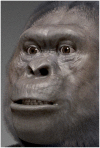Embodied niche construction in the hominin lineage: semiotic structure and sustained attention in human embodied cognition
- PMID: 25136323
- PMCID: PMC4117988
- DOI: 10.3389/fpsyg.2014.00834
Embodied niche construction in the hominin lineage: semiotic structure and sustained attention in human embodied cognition
Abstract
Human evolution unfolded through a rather distinctive, dynamically constructed ecological niche. The human niche is not only generally terrestrial in habitat, while being flexibly and extensively heterotrophic in food-web connections. It is also defined by semiotically structured and structuring embodied cognitive interfaces, connecting the individual organism with the wider environment. The embodied dimensions of niche-population co-evolution have long involved semiotic system construction, which I hypothesize to be an evolutionarily primitive aspect of learning and higher-level cognitive integration and attention in the great apes and humans alike. A clearly pre-linguistic form of semiotic cognitive structuration is suggested to involve recursively learned and constructed object icons. Higher-level cognitive iconic representation of visually, auditorily, or haptically perceived extrasomatic objects would be learned and evoked through indexical connections to proprioceptive and affective somatic states. Thus, private cognitive signs would be defined, not only by their learned and perceived extrasomatic referents, but also by their associations to iconically represented somatic states. This evolutionary modification of animal associative learning is suggested to be adaptive in ecological niches occupied by long-lived, large-bodied ape species, facilitating memory construction and recall in highly varied foraging and social contexts, while sustaining selective attention during goal-directed behavioral sequences. The embodied niche construction (ENC) hypothesis of human evolution posits that in the early hominin lineage, natural selection further modified the ancestral ape semiotic adaptations, favoring the recursive structuration of concise iconic narratives of embodied interaction with the environment.
Keywords: bipedalism; co-evolution; embodied cognition; hominin adaptation; iconic narrative; niche construction; semiotics.
Figures






Similar articles
-
Language and other artifacts: socio-cultural dynamics of niche construction.Front Psychol. 2015 Oct 20;6:1601. doi: 10.3389/fpsyg.2015.01601. eCollection 2015. Front Psychol. 2015. PMID: 26539144 Free PMC article.
-
Triadic (ecological, neural, cognitive) niche construction: a scenario of human brain evolution extrapolating tool use and language from the control of reaching actions.Philos Trans R Soc Lond B Biol Sci. 2012 Jan 12;367(1585):10-23. doi: 10.1098/rstb.2011.0190. Philos Trans R Soc Lond B Biol Sci. 2012. PMID: 22106423 Free PMC article. Review.
-
Proprioceptive Resonance and Multimodal Semiotics: Readiness to Act, Embodied Cognition, and the Dynamics of Meaning.NeuroSci. 2025 May 12;6(2):42. doi: 10.3390/neurosci6020042. NeuroSci. 2025. PMID: 40407615 Free PMC article.
-
Psychedelics, Sociality, and Human Evolution.Front Psychol. 2021 Sep 29;12:729425. doi: 10.3389/fpsyg.2021.729425. eCollection 2021. Front Psychol. 2021. PMID: 34659037 Free PMC article.
-
Environmental hypotheses of hominin evolution.Am J Phys Anthropol. 1998;Suppl 27:93-136. doi: 10.1002/(sici)1096-8644(1998)107:27+<93::aid-ajpa5>3.0.co;2-x. Am J Phys Anthropol. 1998. PMID: 9881524 Review.
Cited by
-
Language and other artifacts: socio-cultural dynamics of niche construction.Front Psychol. 2015 Oct 20;6:1601. doi: 10.3389/fpsyg.2015.01601. eCollection 2015. Front Psychol. 2015. PMID: 26539144 Free PMC article.
-
How to go beyond the body: an introduction.Front Psychol. 2015 May 21;6:660. doi: 10.3389/fpsyg.2015.00660. eCollection 2015. Front Psychol. 2015. PMID: 26052295 Free PMC article. No abstract available.
References
-
- Agamben G. (1999). The Man Without Content. Stanford, CA: Stanford University Press
-
- Allen T. F. H., Starr T. B. (1982). Hierarchy: Perspectives for Ecological Complexity. Chicago, IL: University of Chicago Press
LinkOut - more resources
Full Text Sources
Other Literature Sources
Research Materials
Miscellaneous

